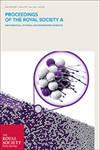Numerical direct scattering transform for breathers
IF 3
3区 综合性期刊
Q1 MULTIDISCIPLINARY SCIENCES
Proceedings of the Royal Society A: Mathematical, Physical and Engineering Sciences
Pub Date : 2024-01-24
DOI:10.1098/rspa.2023.0529
引用次数: 0
Abstract
We consider the model of the focusing one-dimensional nonlinear Schrödinger equation (fNLSE) in the presence of an unstable constant background, which exhibits coherent solitary wave structures—breathers. Within the inverse scattering transform (IST) method, we study the problem of the scattering data numerical computation for a broad class of breathers localized in space. Such a direct scattering transform (DST) procedure requires a numerical solution of the auxiliary Zakharov–Shabat system with boundary conditions corresponding to the background. To find the solution, we compute the transfer matrix using the second-order Boffetta–Osborne approach and recently developed high-order numerical schemes based on the Magnus expansion. To recover the scattering data of breathers, we derive analytical relations between the scattering coefficients and the transfer matrix elements. Then we construct localized single- and multi-breather solutions and verify the developed numerical approach by recovering the complete set of scattering data with the built-in accuracy providing the information about the amplitude, velocity, phase and position of each breather. To combine the conventional IST approach with the efficient dressing method for multi-breather solutions, we derive the exact relation between the parameters of breathers in these two frameworks.呼吸器的直接散射数值变换
我们考虑了存在不稳定恒定背景的聚焦一维非线性薛定谔方程(fNLSE)模型,该模型表现出相干孤波结构--呼吸器。在反向散射变换(IST)方法中,我们研究了在空间中定位的一大类呼吸器的散射数据数值计算问题。这种直接散射变换(DST)程序需要对带有与背景相对应的边界条件的辅助 Zakharov-Shabat 系统进行数值求解。为了求解,我们使用二阶 Boffetta-Osborne 方法和最近开发的基于马格努斯展开的高阶数值方案计算传递矩阵。为了恢复呼吸器的散射数据,我们推导出了散射系数与传递矩阵元素之间的分析关系。然后,我们构建了局部单呼吸器和多呼吸器解决方案,并通过提供每个呼吸器的振幅、速度、相位和位置信息的内置精度恢复整套散射数据来验证所开发的数值方法。为了将传统的 IST 方法与多呼吸器解的高效修整方法相结合,我们推导出了这两种框架中呼吸器参数之间的精确关系。
本文章由计算机程序翻译,如有差异,请以英文原文为准。
求助全文
约1分钟内获得全文
求助全文
来源期刊
CiteScore
6.40
自引率
5.70%
发文量
227
审稿时长
3.0 months
期刊介绍:
Proceedings A has an illustrious history of publishing pioneering and influential research articles across the entire range of the physical and mathematical sciences. These have included Maxwell"s electromagnetic theory, the Braggs" first account of X-ray crystallography, Dirac"s relativistic theory of the electron, and Watson and Crick"s detailed description of the structure of DNA.

 求助内容:
求助内容: 应助结果提醒方式:
应助结果提醒方式:


